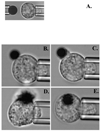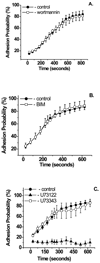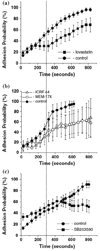Signaling and Dynamics of Activation of LFA-1 and Mac-1 by Immobilized IL-8
- PMID: 21532911
- PMCID: PMC3084010
- DOI: 10.1007/s12195-009-0099-x
Signaling and Dynamics of Activation of LFA-1 and Mac-1 by Immobilized IL-8
Abstract
The dynamic response of neutrophils to interleukin-8 (IL-8) is of central interest in inflammation. Chemokine -induced β(2) integrin dependent adhesion can take several minutes after initial contact with IL-8 as evidenced by increased cell adhesion to intracellular adhesion molecule 1 (ICAM-1). The goal of this study is to identify signaling events that are critical for this response. We demonstrate that neither the PI3K inhibitor wortmannin, nor the PKC inhibitor bisindolymaleimide had any effect on IL-8 induced adhesion to ICAM-1. However, inhibition of PLC with U73122 or stopping the release of intracellular calcium by its downstream effector IP3 with caffeine or 2-aminoethoxydiphenyl borate completely blocked the adhesive response. Chelation of intracellular calcium with BAPTA or extracellular calcium with EGTA completely abrogated neutrophil adhesion to ICAM-1. This adhesion is mediated by LFA-1 (α(L)β(2)) within first 300 seconds after chemokine stimulation, followed by Mac-1 (α(M)β(2)) mediated adhesion, beginning 350 seconds after stimulus. Inhibition of p38MAP kinase results in a time course similar to Mac-1 inhibition, consistent with published evidence that Mac-1 mediated adhesion is p38MAP kinase dependent. These findings confirm a PLC dependent, PKC independent pathway from chemokine stimulus to integrin activation previously identified in other cell types, and demonstrate distinct dynamics and different requirements for LFA-1 vs. Mac-1 activation in primary human neutrophils.
Figures






Similar articles
-
Signaling pathways involved in IL-8-dependent activation of adhesion through Mac-1.J Immunol. 2002 May 1;168(9):4559-66. doi: 10.4049/jimmunol.168.9.4559. J Immunol. 2002. PMID: 11971003
-
Effects of IL-8, Gro-alpha, and LTB(4) on the adhesive kinetics of LFA-1 and Mac-1 on human neutrophils.Am J Physiol Cell Physiol. 2001 Nov;281(5):C1568-78. doi: 10.1152/ajpcell.2001.281.5.C1568. Am J Physiol Cell Physiol. 2001. PMID: 11600420
-
Reprint of Neutrophil cell surface receptors and their intracellular signal transduction pathways.Int Immunopharmacol. 2013 Dec;17(4):1185-97. doi: 10.1016/j.intimp.2013.11.010. Epub 2013 Nov 18. Int Immunopharmacol. 2013. PMID: 24263067 Review.
-
Neutrophil cell surface receptors and their intracellular signal transduction pathways.Int Immunopharmacol. 2013 Nov;17(3):638-50. doi: 10.1016/j.intimp.2013.06.034. Epub 2013 Aug 30. Int Immunopharmacol. 2013. PMID: 23994464 Free PMC article. Review.
-
Fundamentally different roles for LFA-1, Mac-1 and alpha4-integrin in neutrophil chemotaxis.J Cell Sci. 2005 Nov 15;118(Pt 22):5205-20. doi: 10.1242/jcs.02632. Epub 2005 Oct 25. J Cell Sci. 2005. PMID: 16249234
Cited by
-
Human severe sepsis cytokine mixture increases β2-integrin-dependent polymorphonuclear leukocyte adhesion to cerebral microvascular endothelial cells in vitro.Crit Care. 2015 Apr 7;19(1):149. doi: 10.1186/s13054-015-0883-z. Crit Care. 2015. PMID: 25882865 Free PMC article.
-
Genetic ablation of IP3 receptor 2 increases cytokines and decreases survival of SOD1G93A mice.Hum Mol Genet. 2016 Aug 15;25(16):3491-3499. doi: 10.1093/hmg/ddw190. Epub 2016 Jul 4. Hum Mol Genet. 2016. PMID: 27378687 Free PMC article.
-
T cell receptor signaling can directly enhance the avidity of CD28 ligand binding.PLoS One. 2014 Feb 24;9(2):e89263. doi: 10.1371/journal.pone.0089263. eCollection 2014. PLoS One. 2014. PMID: 24586641 Free PMC article.
-
Functional aspects of the interaction between interleukin-8 and sulfated glycosaminoglycans.Biomatter. 2012 Jul-Sep;2(3):142-8. doi: 10.4161/biom.21316. Biomatter. 2012. PMID: 23507865 Free PMC article. Review.
-
Diaphanous-related formin mDia2 regulates beta2 integrins to control hematopoietic stem and progenitor cell engraftment.Nat Commun. 2020 Jun 23;11(1):3172. doi: 10.1038/s41467-020-16911-4. Nat Commun. 2020. PMID: 32576838 Free PMC article.
References
-
- Baggiolini M, Dewald B, Moser B. Human chemokines: an update. Annu Rev Immunol. 1997;15:675–705. - PubMed
-
- Carnevale KA, Cathcart MK. Protein kinase C beta is required for human monocyte chemotaxis to MCP-1. J Biol Chem. 2003;278:25317–25322. - PubMed
-
- Chigaev A, Waller A, Zwartz GJ, Buranda T, Sklar LA. Regulation of cell adhesion by affinity and conformational unbending of alpha4beta1 integrin. J Immunol. 2007;178:6828–6839. - PubMed
-
- Detmers PA, Powell DE, Walz A, Clark-Lewis I, Baggiolini M, Cohn ZA. Differential effects of neutrophil-activating peptide 1/IL-8 and its homologues on leukocyte adhesion and phagocytosis. J Immunol. 1991;147:4211–4217. - PubMed
Grants and funding
LinkOut - more resources
Full Text Sources
Other Literature Sources
Research Materials
Miscellaneous

